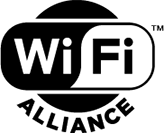Wireless Fidelity according to some sources, while others argue WiFi is simply a trademarked phrase. A wireless networking technology that uses radio waves to provide connectivity between computers and devices in certain areas called hotspots or Wireless Local Area Networks WLAN. WiFi emits frequencies (2.4GHz and 5GHz), which are compatible with most computers and mobile devices.
 Wi-Fi Alliance | |
| Introduced | 21 September 1998 |
|---|---|
| Compatible hardware | Personal computers, gaming consoles, Smart Devices, televisions, printers, mobile phones |
Wi-Fi (/ˈwaɪfaɪ/) is a family of wireless network protocols, based on the IEEE 802.11 family of standards, which are commonly used for local area networking of devices and Internet access. Wi‑Fi is a trademark of the non-profit Wi-Fi Alliance, which restricts the use of the term Wi-Fi Certified to products that successfully complete interoperability certification testing. As of 2010[update], the Wi-Fi Alliance consisted of more than 375 companies from around the world. As of 2009[update], Wi-Fi-integrated circuit chips shipped approximately 580 million units yearly.[needs update] Devices that can use Wi-Fi technologies include desktops and laptops, smartphones and tablets, smart TVs, printers, digital audio players, digital cameras, cars, and drones.
Wi-Fi uses multiple parts of the IEEE 802 protocol family and is designed to interwork seamlessly with its wired sibling Ethernet. Compatible devices can network through wireless access points to each other as well as to wired devices and the Internet. The different versions of Wi-Fi are specified by various IEEE 802.11 protocol standards, with the different radio technologies determining radio bands, and the maximum ranges, and speeds that may be achieved. Wi-Fi most commonly uses the 2.4 gigahertz (120 mm) UHF and 5 gigahertz (60 mm) SHF ISM radio bands; these bands are subdivided into multiple channels. Channels can be shared between networks but only one transmitter can locally transmit on a channel at any moment in time.
Wi-Fi's wavebands have relatively high absorption and work best for line-of-sight use. Many common obstructions such as walls, pillars, home appliances, etc. may greatly reduce range, but this also helps minimize interference between different networks in crowded environments. An access point (or hotspot) often has a range of about 20 metres (66 feet) indoors while some modern access points claim up to a 150-metre (490-foot) range outdoors. Hotspot coverage can be as small as a single room with walls that block radio waves, or as large as many square kilometres using many overlapping access points with roaming permitted between them. Over time the speed and spectral efficiency of Wi-Fi have increased. As of 2019, at close range, some versions of Wi-Fi, running on suitable hardware, can achieve speeds of over 1 Gbit/s (gigabit per second).
Wi-Fi is potentially more vulnerable to attack than wired networks because anyone within range of a network with a wireless network interface controller can attempt access. To connect to a Wi-Fi network, a user typically needs the network name (the SSID) and a password. The password is used to encrypt Wi-Fi packets to block eavesdroppers. Wi-Fi Protected Access (WPA) is intended to protect information moving across Wi-Fi networks and includes versions for personal and enterprise networks. Developing security features of WPA have included stronger protections and new security practices. A QR code can be used to automatically configure a mobile phone's Wi-Fi. Modern phones automatically detect a QR code when taking a picture.

